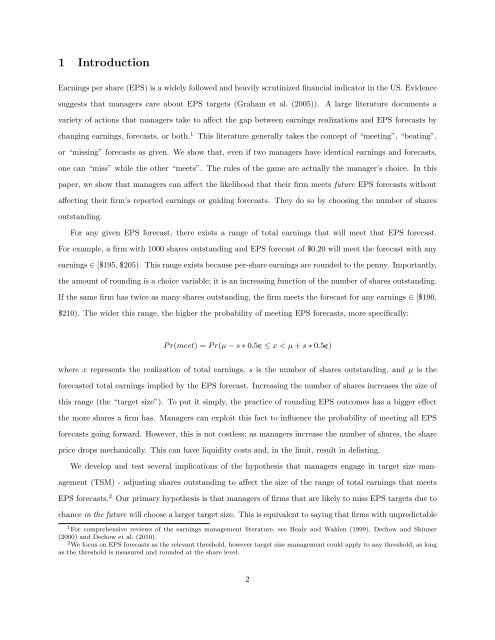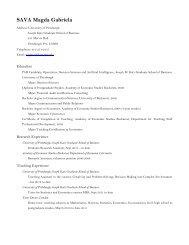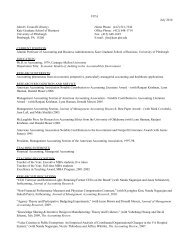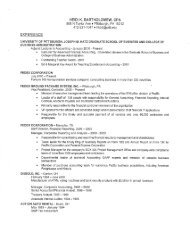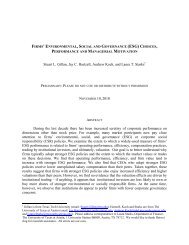Gaming the Float: How Managers Respond to EPS-based Incentives
Gaming the Float: How Managers Respond to EPS-based Incentives
Gaming the Float: How Managers Respond to EPS-based Incentives
You also want an ePaper? Increase the reach of your titles
YUMPU automatically turns print PDFs into web optimized ePapers that Google loves.
1 Introduction<br />
Earnings per share (<strong>EPS</strong>) is a widely followed and heavily scrutinized financial indica<strong>to</strong>r in <strong>the</strong> US. Evidence<br />
suggests that managers care about <strong>EPS</strong> targets (Graham et al. (2005)). A large literature documents a<br />
variety of actions that managers take <strong>to</strong> affect <strong>the</strong> gap between earnings realizations and <strong>EPS</strong> forecasts by<br />
changing earnings, forecasts, or both. 1 This literature generally takes <strong>the</strong> concept of “meeting”, “beating”,<br />
or “missing” forecasts as given. We show that, even if two managers have identical earnings and forecasts,<br />
one can “miss” while <strong>the</strong> o<strong>the</strong>r “meets”. The rules of <strong>the</strong> game are actually <strong>the</strong> manager’s choice. In this<br />
paper, we show that managers can affect <strong>the</strong> likelihood that <strong>the</strong>ir firm meets future <strong>EPS</strong> forecasts without<br />
affecting <strong>the</strong>ir firm’s reported earnings or guiding forecasts. They do so by choosing <strong>the</strong> number of shares<br />
outstanding.<br />
For any given <strong>EPS</strong> forecast, <strong>the</strong>re exists a range of <strong>to</strong>tal earnings that will meet that <strong>EPS</strong> forecast.<br />
For example, a firm with 1000 shares outstanding and <strong>EPS</strong> forecast of $0.20 will meet <strong>the</strong> forecast with any<br />
earnings ∈ [$195, $205). This range exists because per-share earnings are rounded <strong>to</strong> <strong>the</strong> penny. Importantly,<br />
<strong>the</strong> amount of rounding is a choice variable; it is an increasing function of <strong>the</strong> number of shares outstanding.<br />
If <strong>the</strong> same firm has twice as many shares outstanding, <strong>the</strong> firm meets <strong>the</strong> forecast for any earnings ∈ [$190,<br />
$210). The wider this range, <strong>the</strong> higher <strong>the</strong> probability of meeting <strong>EPS</strong> forecasts, more specifically:<br />
P r(meet) = P r(µ − s ∗ 0.5¢ ≤ x < µ + s ∗ 0.5¢)<br />
where x represents <strong>the</strong> realization of <strong>to</strong>tal earnings, s is <strong>the</strong> number of shares outstanding, and µ is <strong>the</strong><br />
forecasted <strong>to</strong>tal earnings implied by <strong>the</strong> <strong>EPS</strong> forecast. Increasing <strong>the</strong> number of shares increases <strong>the</strong> size of<br />
this range (<strong>the</strong> “target size”). To put it simply, <strong>the</strong> practice of rounding <strong>EPS</strong> outcomes has a bigger effect<br />
<strong>the</strong> more shares a firm has. <strong>Managers</strong> can exploit this fact <strong>to</strong> influence <strong>the</strong> probability of meeting all <strong>EPS</strong><br />
forecasts going forward. <strong>How</strong>ever, this is not costless; as managers increase <strong>the</strong> number of shares, <strong>the</strong> share<br />
price drops mechanically. This can have liquidity costs and, in <strong>the</strong> limit, result in delisting.<br />
We develop and test several implications of <strong>the</strong> hypo<strong>the</strong>sis that managers engage in target size management<br />
(TSM) - adjusting shares outstanding <strong>to</strong> affect <strong>the</strong> size of <strong>the</strong> range of <strong>to</strong>tal earnings that meets<br />
<strong>EPS</strong> forecasts. 2 Our primary hypo<strong>the</strong>sis is that managers of firms that are likely <strong>to</strong> miss <strong>EPS</strong> targets due <strong>to</strong><br />
chance in <strong>the</strong> future will choose a larger target size. This is equivalent <strong>to</strong> saying that firms with unpredictable<br />
1 For comprehensive reviews of <strong>the</strong> earnings management literature, see Healy and Wahlen (1999), Dechow and Skinner<br />
(2000) and Dechow et al. (2010).<br />
2 We focus on <strong>EPS</strong> forecasts as <strong>the</strong> relevant threshold, however target size management could apply <strong>to</strong> any threshold, as long<br />
as <strong>the</strong> threshold is measured and rounded at <strong>the</strong> share level.<br />
2


